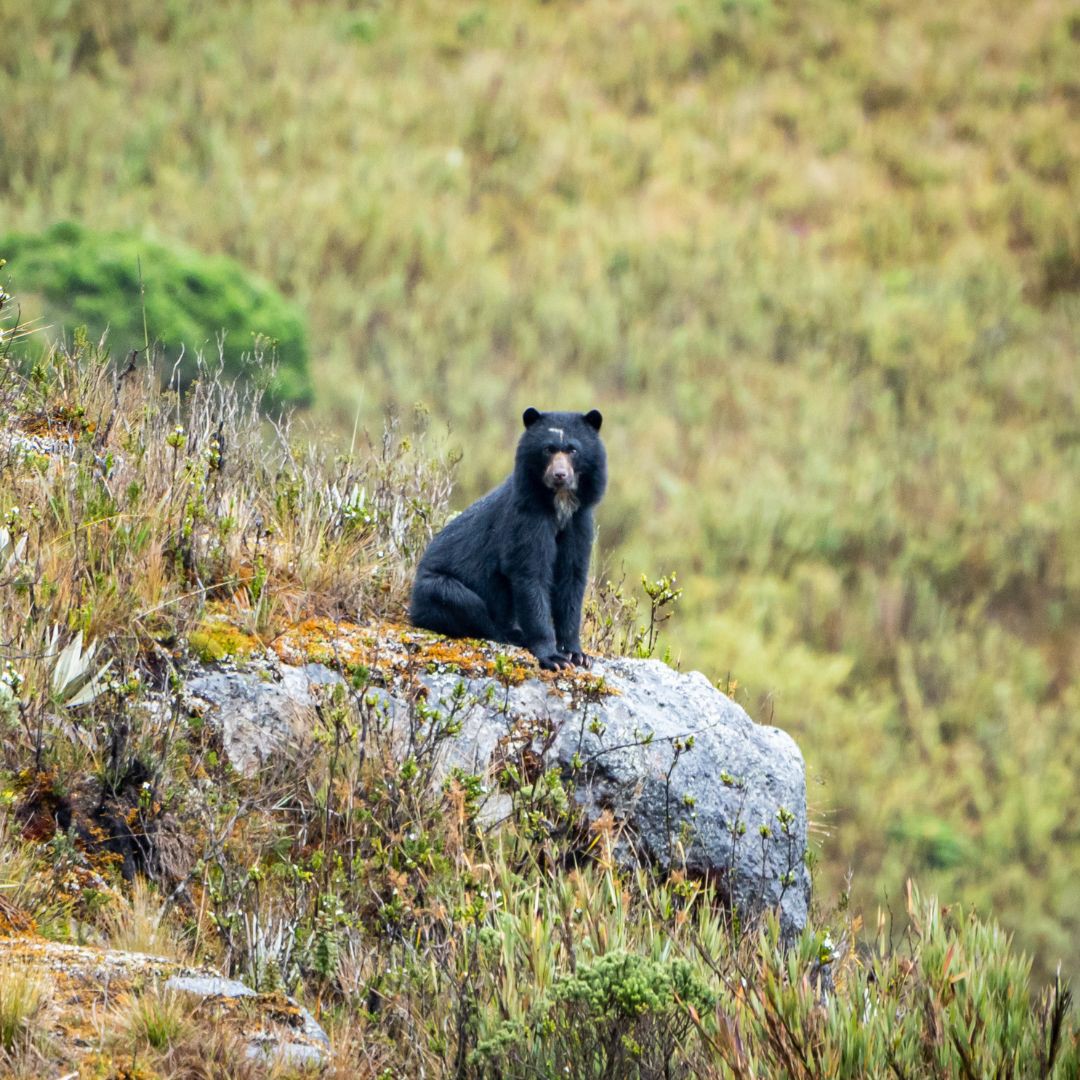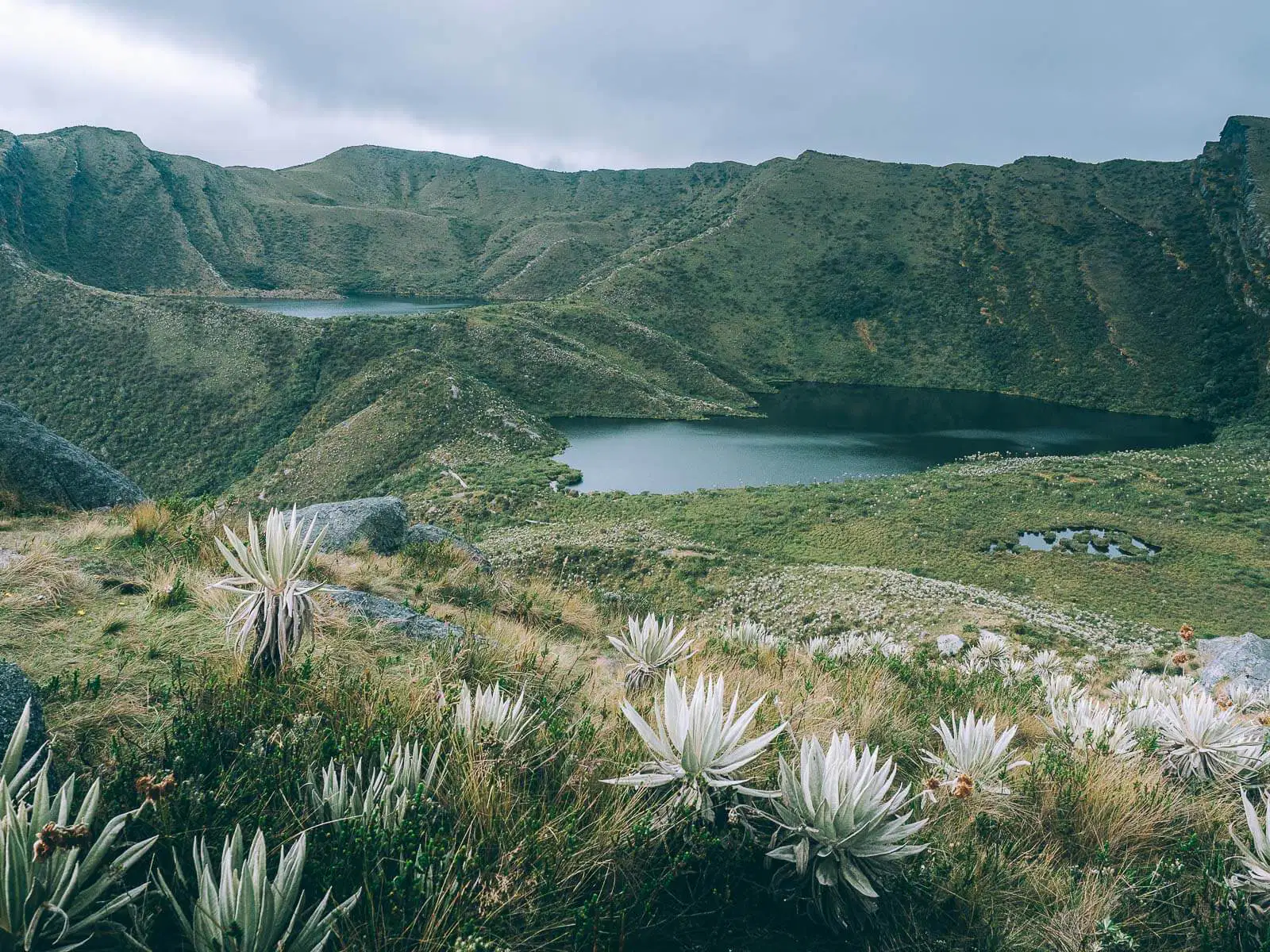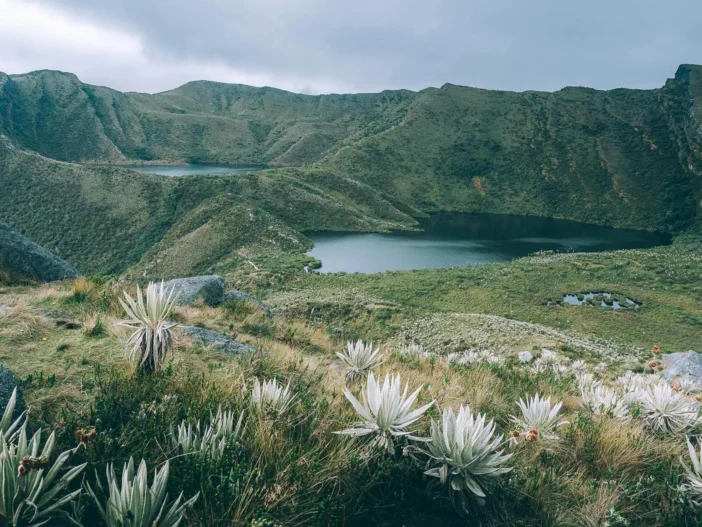Chingaza National Park, located in the Eastern Andes of Colombia, is a hidden gem offering a unique blend of natural beauty, rich biodiversity, and tranquility. For digital nomads seeking an escape from bustling city life, this park provides a perfect retreat into nature. Here are some compelling reasons to visit Chingaza National Park:
- Breathtaking Scenery: The park is home to stunning landscapes, including high Andean forests, moorlands (paramos), and crystal-clear lakes. The diverse terrain offers endless opportunities for hiking, photography, and nature walks.
- Rich Biodiversity: Chingaza is a sanctuary for wildlife, including the spectacled bear, deer, and a variety of bird species. It’s a paradise for nature lovers and bird watchers.
- Peaceful Environment: The park’s remote location ensures a serene and peaceful environment, ideal for focusing on work or simply unwinding. The fresh mountain air and the sounds of nature provide a refreshing change from urban settings.
- Cultural Heritage: The park is part of the ancestral lands of the Muisca people. Exploring Chingaza offers insights into their culture and history, with several archaeological sites and sacred lakes to visit.
Key Highlights
Chingaza National Park offers a plethora of natural wonders and activities that make it a standout destination. Here are the key highlights, expanded with more detail:

1. Laguna de Chingaza
Description: Laguna de Chingaza is one of the park’s most iconic features. This glacial lake, nestled in the heart of the paramo ecosystem, is surrounded by rugged mountains and lush vegetation. The tranquil waters reflect the dramatic landscape, creating a breathtaking and serene environment.
Activities: Visitors can hike around the lake on well-marked trails that offer various vantage points for photography. The area is also ideal for bird watching, as the lake attracts numerous bird species, including ducks, herons, and the Andean condor.
Tips: Early morning visits are recommended to experience the lake in its most tranquil state, often shrouded in mist. Bringing a good pair of binoculars and a camera with a zoom lens can enhance your bird-watching and photography experience.
2. Laguna de Siecha
Description: The Siecha Lakes are a group of three glacial lakes located at a higher altitude than Laguna de Chingaza. These lakes hold significant cultural and historical importance, as they were sacred to the Muisca people, who believed they were inhabited by powerful spirits.
Activities: The hike to the Siecha Lakes is moderately challenging, involving a steep ascent through paramo vegetation. The trail offers stunning panoramic views of the surrounding mountains and valleys. Once at the lakes, visitors can explore the area, enjoy a picnic, and take in the serene beauty.
Tips: Due to the higher altitude, it’s important to acclimatize properly to avoid altitude sickness. Carry plenty of water, snacks, and layers of clothing to adapt to changing weather conditions.
3. Paramo Ecosystem
Description: The paramo is a unique high-altitude ecosystem found in the Andes, characterized by its distinctive flora and fauna. It acts as a vital water source, with its sponge-like vegetation absorbing and releasing water slowly, supplying rivers and lakes downstream.
Activities: Hiking through the paramo is a highlight of any visit to Chingaza. The landscape is dotted with frailejones, tall plants with thick, woolly leaves that are endemic to this ecosystem. The trails vary in difficulty, offering options for both casual walkers and experienced hikers.
Tips: Stay on designated trails to avoid damaging the delicate paramo vegetation. Hiring a local guide can provide deeper insights into the ecology and importance of the paramo.

4. Bird Watching
Description: Chingaza National Park is a bird watcher’s paradise, home to over 200 bird species. The diverse habitats within the park support a wide variety of avian life, from high-altitude specialists to migratory birds.
Activities: Bird watching tours are available, often led by knowledgeable guides who can help you spot and identify different species. Key birds to look out for include the Andean condor, golden-plumed parakeet, black-chested buzzard-eagle, and various hummingbirds.
Tips: Bring a bird guidebook specific to Colombia, along with binoculars and a camera. Early mornings and late afternoons are the best times for bird watching, as birds are most active during these periods.
5. Hiking Trails
Description: The park offers a network of trails that cater to different levels of fitness and experience. These trails traverse diverse landscapes, from dense Andean forests to open paramo and glacial lakes.
Notable Trails:
- Laguna de Chingaza Trail: A relatively easy trail that circles around Laguna de Chingaza, offering scenic views and opportunities to spot wildlife.
- Laguna de Siecha Trail: A moderate to difficult trail leading to the Siecha Lakes, with steep ascents and rewarding vistas.
- Cuchillas de Siecha Trail: A challenging trail that takes you along the ridges of the Siecha mountain range, providing panoramic views of the park.
Tips: Ensure you have appropriate footwear, clothing, and supplies for the hike. Weather in the Andes can change rapidly, so it’s crucial to be prepared for rain, wind, and cold temperatures.

6. Spectacled Bear Sightings
Description: The spectacled bear, also known as the Andean bear, is one of the most charismatic species found in Chingaza. While sightings are rare due to the bear’s elusive nature, the possibility of encountering this magnificent animal adds an element of excitement to any visit.
Activities: Guided wildlife tours can increase your chances of spotting a spectacled bear. These tours often include information on bear behavior, habitat, and conservation efforts.
Tips: Patience and silence are key when trying to spot wildlife. Respect the bear’s natural habitat by keeping a safe distance and not disturbing the environment.
7. Cultural and Historical Sites
Description: Chingaza is rich in cultural heritage, with several archaeological sites and sacred locations that tell the story of the Muisca people. The park’s lakes, in particular, were considered sacred and played a significant role in Muisca rituals.
Activities: Explore the park’s cultural sites with a local guide to gain a deeper understanding of the Muisca’s history and their relationship with the natural world. Some tours focus specifically on the archaeological and cultural aspects of the park.
Tips: Respect the cultural significance of these sites by not disturbing artifacts or taking anything from the locations. Photography may be restricted in certain areas, so always ask your guide for guidance.

8. Wildlife Observation
Description: Beyond the spectacled bear, Chingaza is home to a variety of wildlife, including deer, pumas, tapirs, and numerous smaller mammals and reptiles. The park’s diverse habitats provide ample opportunities for wildlife observation.
Activities: Wildlife tours, often led by experienced guides, can enhance your chances of spotting and identifying different animals. These tours usually take place during the early morning or late afternoon when animals are most active.
Tips: Bring a good pair of binoculars and a camera with a zoom lens. Move quietly and stay attentive to your surroundings to increase the likelihood of wildlife encounters.
9. Ecological Education
Description: Chingaza National Park offers educational programs and interpretive trails that provide insights into the park’s ecology, conservation efforts, and the importance of the paramo ecosystem.
Activities: Join an educational tour or participate in a workshop to learn about the park’s flora, fauna, and conservation initiatives. Many eco-lodges also offer educational activities as part of their stay.
Tips: Take advantage of these educational opportunities to deepen your appreciation of Chingaza’s natural and cultural heritage. Engaging with local guides and experts can provide valuable knowledge and enhance your overall experience.
10. Photography Opportunities
Description: The park’s diverse landscapes, from misty lakes to rugged mountains and unique paramo vegetation, offer endless opportunities for photography. The changing light conditions throughout the day create dramatic and captivating scenes.
Activities: Whether you’re a professional photographer or an amateur enthusiast, Chingaza provides a stunning backdrop for capturing nature’s beauty. Guided photography tours are available for those looking to improve their skills and capture the park’s best angles.
Tips: Bring a tripod, extra batteries, and memory cards. The best times for photography are during the golden hours – early morning and late afternoon – when the light is soft and warm. Respect the park’s rules and guidelines to ensure the preservation of its natural beauty.
Chingaza National Park, with its stunning landscapes, rich biodiversity, and cultural significance, offers a wealth of experiences for digital nomads and nature enthusiasts. Each highlight provides a unique opportunity to connect with nature, learn about the local ecosystem, and enjoy the serenity of this remarkable national park.
How to Get ThereBogotá Unveiled: A 3-Day Adventure in Colombia’s Enigmatic Capital
Chingaza National Park is accessible from Bogotá, Colombia’s capital city. Here’s how you can get there:
By Car
Renting a car is the most convenient way to reach Chingaza. The drive from Bogotá to the park’s entrance takes about 2-3 hours. The route via the towns of La Calera or Guasca is scenic but involves winding mountain roads, so it’s advisable to drive during daylight hours.
By Bus
For a more budget-friendly option, you can take a bus from Bogotá to the nearby towns of La Calera or Guasca. From there, you can hire a taxi or arrange for a local guide to take you to the park entrance.
Guided Tours
Several tour companies in Bogotá offer guided tours to Chingaza National Park. These tours typically include transportation, a guide, and sometimes meals, making them a hassle-free option for visiting the park.
Where to Eat and Stay
Accommodation
- Eco Lodges: There are several eco-lodges near the park that offer comfortable accommodation with a focus on sustainability. These lodges provide a cozy stay with basic amenities and often include meals. Notable options include:
- Monte Verde Lodge: Located near Guasca, this lodge offers rustic cabins and delicious homemade meals.
- Casa en el Agua: Situated by the lake, this eco-lodge provides stunning views and a peaceful atmosphere.
- Camping: For a more immersive experience, you can camp within the park. There are designated camping areas where you can pitch a tent. Make sure to bring your own camping gear and supplies.
- Guesthouses in La Calera or Guasca: If you prefer staying in a town, there are several guesthouses and small hotels in La Calera and Guasca. These accommodations offer basic amenities and are a short drive from the park.
Dining
- Local Eateries: In La Calera and Guasca, you’ll find small restaurants and cafes serving traditional Colombian cuisine. Don’t miss trying local dishes like ajiaco (a hearty chicken soup) and arepas (corn cakes).
- Eco Lodge Restaurants: Many eco-lodges have their own restaurants offering delicious meals made with local ingredients. These meals are often included in your stay or available at an additional cost.
- Picnic in the Park: If you prefer to bring your own food, consider packing a picnic. Enjoying a meal surrounded by the park’s natural beauty is a memorable experience. Remember to carry all trash out with you to preserve the park’s pristine environment.
Potential Co-Working Opportunities
While Chingaza National Park itself is a place to disconnect and enjoy nature, the nearby towns and Bogotá offer several co-working opportunities for digital nomads.
In Bogotá
- WeWork: With multiple locations in Bogotá, WeWork offers modern co-working spaces with high-speed internet, meeting rooms, and communal areas. It’s an excellent option for networking and working in a professional environment.
- AtomHouse: Located in the trendy Chapinero district, AtomHouse provides a creative and vibrant co-working space. They offer flexible memberships, high-speed internet, and comfortable workstations.
- Impact Hub Bogotá: This co-working space is ideal for social entrepreneurs and startups. It offers a collaborative environment, networking events, and various resources to support your work.
In La Calera and Guasca
While these towns are more rural and don’t have dedicated co-working spaces, you can still find suitable spots to work:
- Cafes: Several cafes in La Calera and Guasca have reliable Wi-Fi and a cozy atmosphere, making them good places to work for a few hours. Some recommendations include Café La Huerta in La Calera and Café Campesino in Guasca.
- Eco Lodges: Some eco-lodges offer Wi-Fi in common areas or rooms, allowing you to work while enjoying the tranquil surroundings. Check with the lodge beforehand to ensure they have a stable internet connection.
- Community Centers: Occasionally, local community centers may have spaces where you can work. These might not be advertised, so asking locals for recommendations can be helpful.
Tips for Digital Nomads
- Stay Connected: While the park itself has limited connectivity, having a local SIM card with data can help you stay connected in nearby towns. Providers like Claro, Movistar, and Tigo offer good coverage in Colombia.
- Plan Ahead: Chingaza National Park is remote, so it’s essential to plan your trip in advance. Ensure you have enough food, water, and supplies, as there are limited facilities within the park.
- Respect Nature: Follow Leave No Trace principles to minimize your impact on the environment. Stick to designated trails, avoid disturbing wildlife, and carry out all your trash.
- Weather Preparedness: The weather in the Andes can be unpredictable. Pack layers, a waterproof jacket, and sturdy hiking boots to stay comfortable during your visit.
- Safety First: Always let someone know your itinerary, especially if you’re hiking alone. It’s also wise to carry a basic first aid kit and be aware of altitude sickness symptoms, as the park is located at high elevations.
Chingaza National Park
Chingaza National Park offers a unique and enriching experience for digital nomads. Its stunning landscapes, rich biodiversity, and tranquil environment make it a perfect destination to disconnect from the digital world and reconnect with nature. With proper planning and an adventurous spirit, your visit to Chingaza can be a memorable and rejuvenating escape. Whether you’re hiking through paramo ecosystems, bird watching, or simply enjoying the serene lakes, Chingaza National Park is sure to leave a lasting impression.

